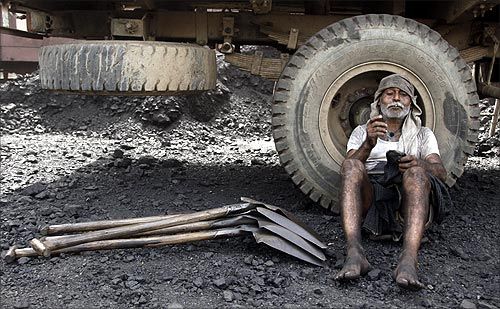 | « Back to article | Print this article |

Nominal GDP, assumed to grow 11.5 per cent for the current financial year in the Budget, has grown only 7.4 per cent in the first half of the current financial year.
Finance Minister Arun Jaitley’s confidence in meeting the fiscal deficit target for 2015-16 faces a challenge from an unexpected quarter -- a significantly lower nominal growth rate in gross domestic product or GDP compared to earlier estimates.
Real GDP growth is measured on constant prices (excluding the impact of inflation or deflation), while nominal gross domestic product growth includes the impact of a change in prices.
In a significant decline in prices, as in the first half of 2015-16 because of a fall in those of crude oil, the economy’s nominal size is likely to grow at a lower rate than earlier estimates and can be the same or less than the real growth in the economy at constant prices.
This impacts the fiscal ratios, since these are based on the nominal size of the economy or nominal GDP.
The Union Budget for 2015-16 had projected the Centre’s fiscal deficit at Rs 5.56 lakh crore (Rs 5.56 trillion) or 3.9 per cent of (nominal) GDP, estimated at Rs 141 lakh crore (Rs 141 trillion).
However, the deficit might rise to 4.1 per cent of GDP, assuming other things remain constant and the real GDP rises by 7.5-8 per cent in 2015-16, which is what most economists believe.
Nominal GDP, assumed to grow 11.5 per cent for the current financial year in the Budget, has grown only 7.4 per cent in the first half of the current financial year.
Even at constant prices, real GDP growth for this period is marginally lower at 7.2 per cent for the first half.
In the first half of 2014-15, the difference between real gross domestic product and nominal GDP growth was much sharper -- at 7.55 per cent real GDP growth at constant prices, compared to 13.5 per cent nominal GDP growth at current prices.
“Everything else remaining constant, the fiscal deficit is expected to go up to 4.1 per cent of the GDP,” said Pronab Sen, chairman, National Statistical Commission.
Wholesale prices fell for the twelfth straight month in October, led by weak demand and subdued commodity prices.
As a result, nominal GDP growth posted lower than the real GDP growth in the second quarter of the current financial year, for the first time.
Nominal GDP growth decelerated to six per cent against 7.4 per cent real GDP growth in that quarter, compared to 8.8 per cent and seven per cent, respectively, in the first quarter.
Deflators, used for converting nominal GDP growth to real GDP expansion, are mainly based on wholesale price indices.
“There would be deterioration in most fiscal parameters on account of deflation, making the fiscal consolidation path more regressive and public debt dynamics adverse.
"Meeting the gross fiscal deficit target of 3.9 per cent of GDP in FY16 could turn out to be a little more challenging than at present,” said Soumya Kanti Ghosh, chief economic advisor at State Bank of India.
The Budget assumption of nominal GDP at Rs 141 lakh crore (Rs 141 trillion) for 2015-16 was a 12.5 per cent growth over actual GDP numbers of 2014-15, released in May.
Last year, the government beat its own deficit target by containing it at 3.99 per cent of GDP at Rs 5.01 lakh crore (Rs 5.01 trillion) against 4.1 per cent of the GDP targeted for the year.
According to the fiscal consolidation road map outlined in the Budget 2015-16, deficit is to be brought down to 3.9 per cent of the GDP in FY16, 3.5 per cent in 2016-17 and to three per cent by 2017-18.
This was a year’s deferment of the road map given by Jaitley’s predecessor, P Chidambaram, whose schedule prescribed the deficit to come down to 3.6 per cent in 2015-16 and three per cent the following year.
Economists expect nominal GDP to clock 7.5-8 per cent growth during FY16 on account of continuing deflation, which might start correcting only by January as the base effect wears off.
ldquo;While capital expenditure (capex) is up, we do not have a sense of what the prices would be.
"If they have come down, the government will be able to meet the investment target at lower expenditure than budgeted, which will be a positive,” said Sen.
Inflation declining on account of oil prices has provided a bonanza to the government in terms of indirect taxes but that could be offset by weak disinvestment activity, he added.
The Centre’s fiscal deficit, or gap between government expenditure and revenue, was 74 per cent of the Budget estimate in the seven months till October at Rs 4.11 lakh crore (Rs 4.11 trillion), much lower than the 89.6 per cent seen in the corresponding period last year.
“If the government was to hold on to its revised fiscal consolidation path to maintain credibility, it will have to either increase its revenue by Rs 17,442 crore (Rs 174.42 billion) or decrease expenditure by Rs 17,442 crore (Rs 174.42 billion) to maintain the fiscal deficit at the initially projected 3.9 per cent,” said Ghosh of SBI, adding, a reduction in capex will be detrimental for growth.
D K Joshi, chief economist at CRISIL, said the two things to watch are the deficit ratio and quantum.
“If there is a deviation due to the base getting reduced, people will understand that, unless it is a very significant aberration. Tax collections have been somewhat decent, so there will be a fair chance of meeting the deficit target,” added Joshi.